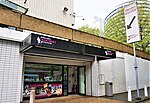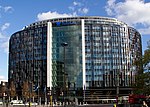Astley's Amphitheatre
Buildings and structures demolished in 1893Cite NIE template missing title parameterEntertainment in LondonFormer buildings and structures in the London Borough of LambethFormer theatres in London ... and 2 more
Theatres completed in 1773Use British English from May 2015

Astley's Amphitheatre was a performance venue in London opened by Philip Astley in 1773, considered the first modern circus ring. It was burned and rebuilt several times, and went through many owners and managers. Despite no trace of the theatre remaining today, a memorial plaque was unveiled in 1951 at its site at 225 Westminster Bridge Road.
Excerpt from the Wikipedia article Astley's Amphitheatre (License: CC BY-SA 3.0, Authors, Images).Astley's Amphitheatre
Westminster Bridge Road, London Lambeth (London Borough of Lambeth)
Geographical coordinates (GPS) Address Nearby Places Show on map
Geographical coordinates (GPS)
| Latitude | Longitude |
|---|---|
| N 51.5002 ° | E -0.1183 ° |
Address
Gassiot House
Westminster Bridge Road
SE1 7PD London, Lambeth (London Borough of Lambeth)
England, United Kingdom
Open on Google Maps









